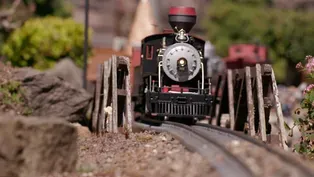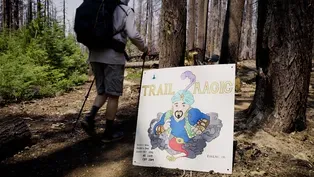Oregon Field Guide
Mike Houck and the great blue heron
Clip: Season 36 Episode 5 | 10m 20sVideo has Closed Captions
Urban naturalist Mike Houck tracks great blue herons on the Willamette River.
Mike Houck tracks the lifecycle of the great blue heron on Portland's Willamette River while reflecting on his long career bringing green space to the built environment.
Oregon Field Guide
Mike Houck and the great blue heron
Clip: Season 36 Episode 5 | 10m 20sVideo has Closed Captions
Mike Houck tracks the lifecycle of the great blue heron on Portland's Willamette River while reflecting on his long career bringing green space to the built environment.
How to Watch Oregon Field Guide
Oregon Field Guide is available to stream on pbs.org and the free PBS App, available on iPhone, Apple TV, Android TV, Android smartphones, Amazon Fire TV, Amazon Fire Tablet, Roku, Samsung Smart TV, and Vizio.
Providing Support for PBS.org
Learn Moreabout PBS online sponsorship(wind whooshing) (birds trilling) - Okay.
(wind whooshing) (birds trilling) I am hearing a white-breasted nuthatch.
There's the song sparrow.
There's the bewick's wren singing.
(Mike whistles) (bird trills) Hear that trill?
That's a spotted towhee.
He's up there advertising himself.
- [Narrator] Walking around with Mike Houck is a little like hanging out with Dr. Doolittle - Red-tailed hawk, beauty.
(Mike whistling) He is not going to call back.
(chuckles) - [Narrator] For decades, first as urban naturalist for the Bird Alliance of Oregon, and today as director of the Urban Greenspaces Institute, Mike has been an advocate for bringing nature to cities.
- If you look up into the tree, there's a screech owl.
When I started as urban naturalist in 1982, (camera shutter clicking) the very first land-use planner I talked to said, "Mike, there's no place for nature in the city."
Nice!
And that's been the struggle for over 40 years now, it's to get places like this protected.
- [Narrator] By places like this, Mike means Oaks Bottom, a 160-acre wetland in Southeast Portland.
- This is what is now the South Meadow.
And it used to be called the south fill because it literally was a landfill, and it was on fire, there was smoke.
And in 88, we called for this to be protected as a wildlife refuge.
There's a huge diversity of wildlife here.
Something on the order of 150 species of birds have been seen here.
There are river otter here, there are beaver here.
There are mink here, there are coyotes here.
There are deer here, and of course, great blue herons.
Ah, there they are.
- [Narrator] Perhaps more than any other bird, the great blue heron would become one of Mike's most powerful partners in the fight to bring nature to the urban landscape.
The iconic bird used to be found almost everywhere in the Willamette Valley.
- But bald eagles move in.
The herons took off because of the eagles continuing to harass them.
So you know, nature's dynamic.
- [Narrator] With the return of bald eagles, finding a heron colony has become challenging.
- [Mike] This is awesome.
- [Narrator] Mike took us to this one just south of Portland, where we could follow these magnificent birds as they pair up and raise their offspring.
- Great blue heron nesting begins in February, where they come back.
They do reuse the same nests frequently.
We got pairs in the nest, and once that's occurred, there's a lot of remodeling that goes on.
And the male will fly off and snap wigs off trees, fly back to the female, beak the twig to the female, she will grab it.
But they'll also just kind of, I don't know, I'd call it cuddling almost, where they maybe rub their necks together.
So there's a lot of physicality to it.
They've got these fabulous plumes that flare up.
And they're like, "Hey, baby," right?
Not unlike a lot of humans.
And through that process, they bond.
They're very solitary birds, but in order to be safe in their nesting, they come together in a colony 'cause bald eagles will prey on the young.
And what they've documented is a 60% decline of herons from 1975 to present, and a more than doubling of the population of bald eagles.
So one of the most surprising thing to a lot of people, I think, is the region is full of nature.
- [Narrator] But that wasn't the conventional wisdom back in the day.
- [Mike] While Portland was being touted as this green oasis, the fact of the matter was, at that time, nature did not play a role.
And it wasn't until the late 80s, early 90s that people started rethinking the city.
And I just came along at the right time, and we rode that wave.
- [Narrator] But riding that wave sometimes requires some creative maneuvers.
- In the urban nature game, there are no silver bullets.
So you try every strategy you can.
You cannot rely on just one approach.
- [Narrator] Efforts to protect Oaks Bottom went back decades.
But the city's reluctance to declare it a wildlife refuge drove Mike to tap a backdoor contact at the Oregon Department of Fish and Wildlife.
- [Mike] I talked him into giving me 40 Wildlife Refuge signs, and a friend and I went all around Oaks Bottom and tacked up signs high enough that nobody could reach them.
- [Narrator] Though there's no actual proof this helped, pretty soon, the city declared Oaks Bottom its first official urban wildlife refuge.
(birds trilling) By April, heron parents are busy looking after up to four chicks.
- [Mike] You have to struggle to see their little feathery heads popping up over the edge of the nest.
They look really kind of cute, you know, like all young do.
- [Narrator] Alas, that cuteness does not last.
- They're in their awkward teen stage.
They more look like feathered dinosaurs.
And everybody's fighting for food and just making a racket.
Oh, look at that, so this guy, the top of his head is totally punked out.
He's a young punker.
You know, the adult is truly a spectacularly beautiful bird with those long plumes, and they're so graceful.
People love them, so it just seemed logical to have that be the city bird.
- [Narrator] In 1986, Mike was at a meeting of wildlife managers listening to a speech by Portland Mayor Bud Clark.
In addition to being turned on by Art, Bud was also a heron fan.
- He mentioned great blue herons probably 20 times in the course of his talk.
I literally grabbed him by the arm, "Bud!
I think you should declare the great blue heron as Portland's city bird."
He said, "Whoop, whoop!"
(Bud hoots) - [Narrator] And on December 10th, 1986, the city council declared the great blue heron Portland's official city bird.
After the meeting, Mike headed over to a local brew pub and told the brew master about the new city symbol.
- And he said, "Hmm, I just brewed a new ale I haven't named yet... what do you think?"
- [Narrator] The eponymous ale also helped lubricate deals with the city's local power brokers.
- Everybody got to know one another, and without that, we would not have accomplished 1/10 of what we have with regard to nature in the city.
- [Narrator] Mike then talked a local muralist into painting a heron on the Portland mausoleum, with donated paint, of course.
- Just another strategy.
It's like, there's another thing.
People will stop and look at that heron and ask why that's on that building.
(boat system beeps) (boat engine rumbling) (water rustling) (boat engine rumbling) There's an osprey.
- [Narrator] By late May, the young herons have grown out of their awkward teenage stage.
- Oh my god, you know what?
I think we have a young one.
It's almost adult size, wow.
They're not quite, ooh, one looks like he's ready to jump onto another branch.
We're going to have branchers here pretty soon.
- [Narrator] These branchers, as they're known, are starting to venture away from the nest and try out their wings.
But they have company.
- Uh, bald eagle right overhead.
He just landed right here.
(bald eagle trilling) And a second one coming in.
Oh my God.
(chuckles) (bald eagle trilling) When an eagle comes in like this, the young can get knocked out of the nest.
You know, they start flailing around, and they're not ready to fly yet.
So... that would be tragic.
I'd hate to see this colony abandoned like a lot of the others have been.
I hope they can coexist in this case.
(boat engine rumbling) (birds trilling) - [Narrator] A few weeks later, it looks like Mike may have gotten his wish.
- He's walking, he turned around.
He's looking like he wants to take off, stretching his wings.
Upper left, he's standing up again.
Come on buddy.
Boom!
Awesome!
Obviously, this heron colony has been pretty successful.
The fact that eagles have more than doubled is good news.
The fact that herons have gone down 60 to 70%, is that bad news, or is that something that existed pre-development?
Maybe we're just getting back to that equilibrium, I don't know.
But the herons are still here, I'm still here, and it's just kind of cool to think that more than a half a century later, we're all still here.
(chuckles) (birds trilling) (no audio) - Getting inspiration for your next adventure, it's kind of why you're here, right?
You can support more of what we do on Oregon Field Guide and everything else you see on OPB by going to opb.org/video and becoming a sustaining member.
(gentle bright music)
Video has Closed Captions
Garden Railways combine model railroads with imaginative outdoor landscapes. (8m 54s)
Video has Closed Captions
Meet the Leesons, Eugene Trail Angels serving up snacks and support for PCT hikers! (6m 59s)
Providing Support for PBS.org
Learn Moreabout PBS online sponsorship












